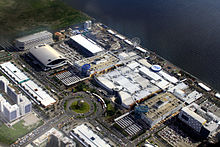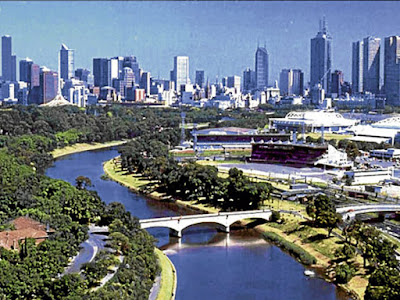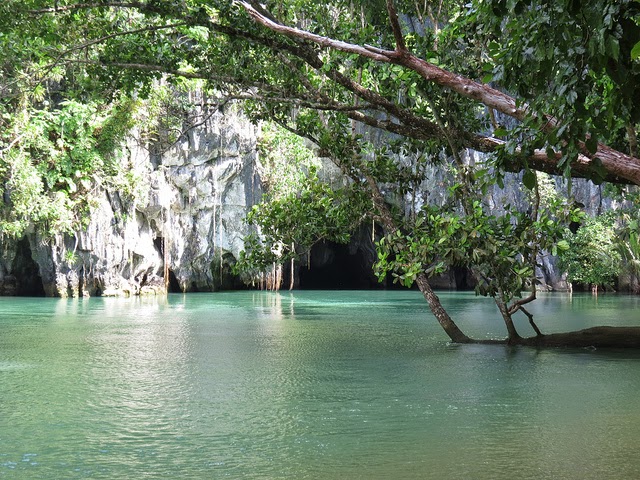SM Mall of Asia
SM Mall of Asia is a shopping mall in Bay City, Pasay, Philippines, near the SM Central Business Park, the Manila Bay, and the southern end of Epifanio de los Santos Avenue(EDSA).
Owned and developed by SM Prime Holdings, the largest mall chain owner and developer in the Philippines, it has a land area of 42 hectares, a gross floor area of approximately 406,962 square metres (4.38050×106 sq ft), and attracts a daily average foot traffic of about 200,000 people.
It is the 10th largest shopping mall in the world in terms of gross leasable area. When it opened in 2006 it was the largest shopping mall in the Philippines until SM City North EDSA was redeveloped in 2008, and was relegated to third place by the expansion of SM Megamall in 2011.
One of the largest malls in the Philippines (407,000 sq.M.). It is located at the coastal areas of manila & has also many outstanding features.
Special features:
-Has an indoor science park with planetarium
The mall is the centerpiece project of SM Prime at the SM Central Business Park, where five one-story buildings serve as the company's corporate offices (the sixth building being occupied by TeleTech Holdings, Inc. as their flagship site in the country).
The SM Mall of Asia's design team includes Arquitectonica, design architect; GHT Services, project manager, and Hilmarc's Construction Corp. (for the south parking building, main mall, and entertainment mall) and Monolith Construction Development Corp. (for the north parking building), general contractors.
The mall would have opened before Christmas Day of 2005 but had been delayed due to hitches in the delivery of construction materials. Frequent rains in the last quarter of 2005 also delayed the turnover of mall space to tenants. SM Prime decided to move the opening date to March 3, 2006.
On February 27, 2006, local newspaper Manila Standard Today, reported that a team of Pasay City engineers found huge cracks underneath the structure, which was causing the structure to vibrate.[7] When questioned about the inspection, the Pasay City Engineering Department denied making any statement regarding defects in the Mall of Asia. Engineer Edwin Javaluyas, Pasay City engineering officer, in his letter to SM Prime Holdings Inc., said he never stated that the city hall's engineering department inspected the Mall of Asia on February 23, 2006.
SM Prime however decided to move the opening to May 21 of that year. Jeffrey Lim, corporate information officer of SM Prime Holdings, emphasized that a rescheduling of the mall's opening was made to give the company an opportunity to allow more tenants to open shops and denied that the change was due to structural defects.
The mall was officially inaugurated by President Gloria Macapagal-Arroyo with a special screening of Everest in the San Miguel Coca-Cola IMAX Theater. The movie was shown three days after Philippine tri-athlete Leo Oracion reached the treacherous mountain's summit.
Mall of Asia consists of four buildings interconnected by walkways; the main mall, the entertainment mall, and the north and south carpark buildings.
The main mall includes shopping and dining establishments and the food court. The entertainment mall is a two-story complex, most of which is open-air, and faces Manila Bay. Both have concierge desks.
The mall's 5,000 parking spaces are divided across two, six-story parking buildings conveniently designated the north and south parking buildings. The south parking building houses the mall's official SM Department Store, while the mall's supermarket, the SM Hypermarket is located at the north parking building.
Since opening in 2006, visitors to the mall have been welcomed by large steel framed globe on a roundabout at the southern tip of Epifanio de los Santos Avenue. In 2009, the globe was turned into Globamaze, an LED display.[
The mall includes branches of all of the standard anchor stores found in most of the SM Supermalls. The first-ever branch of Taste Asia, one of the SM Supermalls' food court brands, is located right outside the mall's supermarket, the sprawling SM Hypermarket.
One of the mall's main attractions is the first ever IMAX theater in the country, along with a Director's Club Theater for intimate screenings (30 La-Z-Boy seats), a Premiere Cinema, and the CenterStage Cinema which can used for live musical concerts and theatrical performances. The San Miguel-Coca-Cola IMAX Theatre is one of the world's biggest IMAX screens in 3D including 2D screenings.
In addition to the mall's special theaters, it also has six regular two-tiered movie theaters similar to the ones found in almost every SM Supermall.
The mall features the Philippines's first Olympic-sized ice skating rink. At 61 by 30 meters, the rink is described as the biggest of its kind in Southeast Asia. It can accommodate both recreational and competitive figure skating, as well as ice hockey. Along with plain access and skate rentals, the rink's operators also offer training programs in both figure skating and ice hockey. Several ice skating competitions have been held at the mall's ice skating rink, the most prestigious yet having been Skate Asia 2007. It was also the first time that the Philippines had hosted any international ice skating event.
The mall's open-air music hall directly facing the sea has also held several events, contests and concerts.
The mall also provides office space. Dell International Services, a subsidiary of Dell, Inc. once occupied a 13,470.5-square meter area at the second floor of the north parking building of the mall. At present, Teleperformance has taken over that space.
OneE-com Center (known as SM Corporate Center) provides for the office and workspace requirements of prospective IT-related locator companies and to support office and backroom operations of business process outsourcing. The first building, OneE-comCenter, began March 8, 2006. The building was completed in the first week of October 2007. Its first occupant, Fitness First opened its doors on October 12, 2007. Office started to fill on January 2008.
The 105,857 square meter, 10 storey OneE-comCenter was designed by international firm Arquitectonica and Architect Felix Lim. The building itself will have a total of 71,934 square meters available for lease. Seven floors will be allotted for office space, and the ground floor for commercial use. The average floor plate will be 9,000 square meters. There will be two and a half levels for parking with 600 slots.
The building is connected by a second level pedestrian bridgeway to the mall's north parking building
The Two E-com Center is the second phase of the four BPO towers in the Mall of Asia complex. It has a gross floor area of 107,862 square meters and consists of two (2) Towers – Fifteen (15) storey office building with retail areas at Ground and 4th Floor Level. The parking areas are located at the 2nd and 3rd floor level. The TwoE-com Center is designed by the world-renowned firm Arquitectonica.
An esplanade was constructed at the back of the mall where it served as the observation center for the First World Pyro Olympics in December 2005. The second World Pyro Olympics were held at the SM Mall of Asia's boardwalk area in early January, 2007.[
The Esplanade was also the venue for Lovapalooza 2, wherein more than 5,300 couples kissed for 10 seconds on February 10, 2007, breaking Hungary's 4,445 in the Guinness World Records. Also, an events venue named One Esplanade was constructed here. One Esplanade is usually used for product launches, parties, and other events.
The Mall of Asia Eye is a 55-metre (180 ft) tall Ferris wheel which opened to the public at the SM Mall of Asia complex on December 18, 2011. It has 36 air-conditioned gondolas, each able to carry up to six persons, giving a maximum capacity of 216 passengers.
The Mall of Asia Arena is an indoor arena within the SM Mall of Asia complex which has a seating capacity of 16,000 and a full house capacity of 20,000. The arena is the alternative venue of the Philippine Basketball Association and the main venue of the University Athletic Association of the Philippines.
On October 13, 2007, the P313-million SM Science Discovery Center, the first of its kind in the world, was opened. SM Prime Holdings has partnered with US-based Leisure Entertainment Company (LEC) Worldwide for the SDC, it features a digital planetarium and a wide range of technology and science-themed exhibits.
In 2009, it was renamed into Nido Fortified Science Discovery Center after being bought by Nestlé Philippines.
In 2014 Nido Fortified Science Discovery Center Has Rebranded To The EXPLOREUM Managed By SM Lifestyle Entertainment Inc, Which features 118 new interactive exhibits and over 100 non-interactive exhibits in eight major interactive galleries namely the Natural World, Human Adventure, Zoom, Connect, Cyberville, Space Camp, the Living Earth, and Science Park.
The SMX Convention Center (formerly Maitrade Expo and Convention Center) (Project Name: MAITrade) is the Philippines' largest privately run exhibition and convention center. The 46,647-square meter building will have three floors and basement parking with a total leasable area of 19,800 square meters featuring large exhibition areas and function rooms. The convention center can fit approximately 6,000 people.
The groundbreaking was held on March 23, 2006. The P900 million project, was completed and inaugurated on November 5, 2007. It is used as an alternate with the nearby state-run Philippine International Convention Center and World Trade Center Metro Manila located in the CCP Complex.
The 46,647-square meter building is composed of three floors and a basement parking with a total leasable area of 19,800 square meters. The Architect, Arch. Jose Siao Ling, designed the structure maximizing the use of space, giving exhibitors flexibility and options in terms of their specific area requirements. The exhibition area at the ground level will have a floor area of 9,000-square meters, which can be divided into four halls. Commercial shops will be located along the perimeter. A bridgeway on the second level will connect SMX Convention Center to the mall's south parking building. The third level will have a total floor area of 8,730 square meters, which can be divided into six halls for functions and conventions, along with nine meeting rooms.
A new 2-level expansion will be built at the top of the main mall to be built next year and set to finish by 2017. The new expansion will feature an iconic rooftop football field at the mall's 4th level and all-new shops and restaurants at the mall's third level. The new expansion will be accompanied by major changes on the mall layout and tenant mix. For instance, the ice skating rink will be moved on the topmost floor of the mall. In light of the preparations for the new expansion, a new parking floor in the parking building is constructed together with the newly opened steel parking near the IMAX Theater. The new expansion will relegate SM Mall Of Asia to be the biggest mall in the Philippines, surpassing SM Megamall's 490,000 square meter floor area. It will add an estimated Gross Floor Area of 140,000 square meters, adding it to the existing 390,000 square meters floor area which will be equated to 530,000 square meters
Tri - Noma
TriNoma (Triangle North of Manila) previously named North Triangle Commercial Center (NTCC) is a large shopping mall in Quezon City, Philippines, owned by property development firm Ayala Land. Opened in 2007, the mall is located on the side of Epifanio de los Santos Avenue, east of the North Avenue MRT Station in Quezon City, giving significant market competition to the nearby SM City North EDSA as one of the largest malls in Metro Manila. It is also one of two malls that will be serving Ayala Land's Vertis North township, which is located beside the mall, along with a new lifestyle block mall (similar to Makati's Greenbelt, which was also developed by Ayala Malls) that has been planned within the currently
in-progress township.
TriNoma is located at the corner of EDSA and North Avenue in Quezon City. Strategically located in "North Triangle", the mall is bound by three major thoroughfares, namely, North Avenue, EDSA and Mindanao Avenue Extension. Located on a 20-hectare parcel of land, TriNoma has a gross leasable area of 195,000 square meters, which includes the mall's major anchor, The Landmark Supermarket and Department Store.
It is directly connected to the North Avenue MRT Station as the mall itself sits atop the MRT-3 Depot. It will be almost connected to the Line 1's proposed North Avenue LRT Station. A pedestrian overpass has also been constructed to connect with SM City North EDSA.
The site of TriNoma used to be the location of "People's Park", a flea market built by former Mayor Brigido R. Simon, Jr. as a livelihood project for the City's nearby informal settlers (the actual market's size, though, only covered what is now TriNoma's public transportation terminal and outdoor pay parking). It was closed in 1995 by then Mayor Ismael A. Mathay, Jr. to give way for the construction of the MRT-3 depot to service commuters along Epifanio de los Santos Avenue (EDSA).
The MRT-3 consortium composed of Fil-Estate Holdings and Ayala Land decided to make the depot underground rather than a regular depot similar to LRT-1 due to its commercial viability as a shopping mall. When the MRT-3began operations on December 1999, the construction of the mall was not immediately undertaken due to lack of funding. The North Triangle Depot Commercial Corporation was incorporated in 2001 with Fil-Estate spearheading the development and Ayala Land as minority stockholder.
From December 1999 to December 2004, the depot was idle space until an agreement was signed between Ayala Land and the Fil-Estate Group with the former buying the latter's 30.89% stake in the North Triangle Depot Commercial Corporation for P600.1 million, and in exchange a land situated along Ayala Avenue,
Makati and other shares.
Ayala Land started constructing the mall on June 2005 under the project name "North Triangle Mall" but was later changed to "TriNoma" inspired by the redevelopment of industrial
district TriBeCa.
TriNoma was officially launched in a private ceremony on April 25, 2007. It was inaugurated by officials of Ayala Land, its developer, and authorities of Quezon City, led by Mayor Feliciano Belmonte, Jr.. Members of the media were also present.
The soft opening was originally slated for May 3, 2007, but was delayed by structural elements that were yet to be finished. It finally opened to the public on May 16, 2007. The 3.5 billion peso mall was officially launched on October 16, 2007 by the former president, Gloria Macapagal-Arroyo and former vice president,
Noli de Castro (currently an ABS-CBN broadcaster and
TV Patrol anchor).
The mall was the first building constructed in the 62.3 hectare Triangle Exchange district of Triangle Park and of Ayala Land's Vertis North project. Vertis North is within the 250.6-hectare Quezon City Central Business District (also known as Triangle Park) to redevelop the areas of North Triangle (North Avenue, EDSA, Quezon Avenue), East Triangle (East Avenue, EDSA, Quezon Avenue) and the Veterans Memorial Medical Center (VMMC) property (North Avenue)
The mall is composed of four major levels with two minor ones on ground and on grade. The mall is characterized by alfresco areas punctuated with water features and landscaping. These water features flow into pools at the TriNoma Park, an oasis that sits atop the mall.
The TriNoma Park is a two-level park spanning a total of one hectare. It is home to an array of restaurants offering varied cuisines. The Park also houses a stage, surrounded by pools of water, for performances and shows. The TriNoma Park is linked to the mall's 3rd level.
The mall has two parking buildings, North Ave Parking Building and Mindanao Parking Building. Parking is also available in open areas.






















![[Photo of Magellan Cross]](http://chinabusinessphilippines.com/images/articles/places/magellan_cross.jpg)
![[Photo of CamSur Water Sports]](http://chinabusinessphilippines.com/images/articles/places/camsur1.jpg)
![[Photo of Burnham Park, Baguio]](http://chinabusinessphilippines.com/images/articles/places/baguio.jpg)
![[Photo of Mt. Apo, Davao]](http://chinabusinessphilippines.com/images/articles/places/davao.jpg)
![[Photo of Boracay Beach]](http://chinabusinessphilippines.com/images/articles/places/boracay.jpg)
![[Photo of Cagayan de Oro]](http://chinabusinessphilippines.com/images/articles/places/cdo.jpg)
![[Photo of San Agustine Church]](http://chinabusinessphilippines.com/images/articles/places/zambales.jpg)
![[Photo of Chocolate Hills]](http://chinabusinessphilippines.com/images/articles/places/bohol.jpg)


